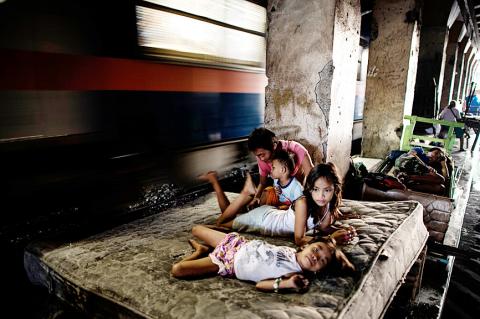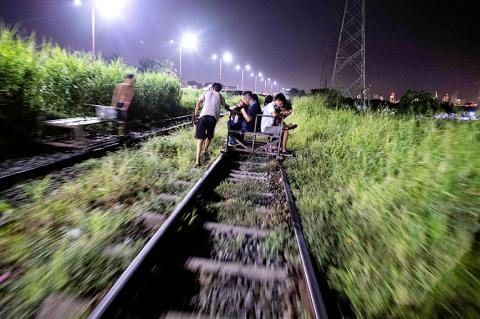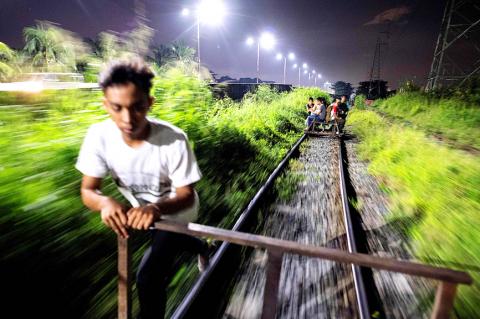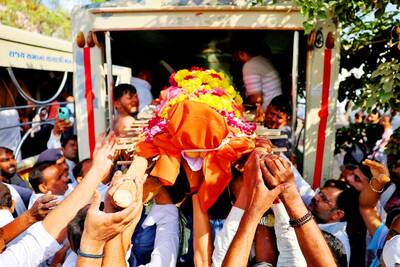As soon as the train rumbles past, the men heave their home-made pushcarts back onto the tracks and passengers hop aboard — cheating death and beating Manila’s notorious traffic.
Scores of commuters in the city of about 12 million are propelled to their destinations daily by so-called “trolley boys” pushing metal carts that ply a few segments of the sprawling capital’s railroads.
Passengers save time and money — paying just 10 pesos (US$0.20) a trip — but must face the constant risk of being crushed by a passing locomotive if they or the trolley boys do not move fast enough.

Photo: AFP
“Our job here is very dangerous, you need to know what time the train will pass by,” said 57-year-old Rene Vargas Almeria, who has been at it for nearly 20 years.
Commuter trains travel nearly two dozen times a day along the 1.2km stretch of rail in Santa Mesa District, where authorities grudgingly tolerate the carts due to their popularity.
The trolley boys also ply a few other stretches of Manila’s battered rail system, which carries an average of 45,000 passengers a day.

Photo: AFP
Incredibly, casualties are relatively rare.
Police do not keep statistics, but said they could not remember the last time a fatality occurred.
The same cannot be said of close calls — anyone who spends time pushing or riding the carts seems to have a hair-raising story to share.

Photo: AFP
Rodolfo Maurello’s scariest near-miss in almost two decades as a trolley boy came when he failed to notice the train behind him as he was pushing a cart packed with passengers.
“The train was just meters away,” the 60-year-old said, recalling how he turned around with only seconds to spare and waved it to a stop. “The sound of its brakes screeching was very loud.”
Almeria has a similar tale, which happened one day when his mind wandered and his sole passenger was looking the other way.
“I swung my head around and saw the train coming and yanked my trolley off the tracks,” he said. “It was really close.”
On a good day the trolley boys can make up to US$10, ferrying passengers seeking to escape Manila’s infamous gridlock — a collision of poor infrastructure, weak public transit and an increasing number of cars.
Even as Manila’s population grew 50 percent from 1995 to 2015, investment in the city’s creaking transport system has not kept up, opening a gap for informal options like the pushcarts to fill.
Most journeys lack life-or-death drama, with workers in office attire and students clutching their lunch bags and pecking at their smartphones, a tattered beach umbrella providing the only protection from the burning sun or frequent downpours.
“There is no traffic,” 46-year-old Noemi Nieves told reporters. “It is convenient for us and the fare is just right for our budget.”
Despite the risks and minimal comforts, commuters say the trolley carts offer a welcome shortcut to spending hours in traffic only to travel a few kilometers.
Danica Lorraine, 25, shaves nearly an hour off her daily commute, spared from having to take two additional buses each way. “You just need to be cautious — very, very, very cautious,” she said.
Kerkleen Bongalon, a teacher, has — for the most part — gotten over her unease at riding the carts.
One stretch of her journey passes over the Pasig River — with a 15m plunge between the rail tracks and the water below.
“At first it was scary,” she said. “I don’t know how to swim so if something happens while we are on the bridge I really don’t know what would happen, but nothing will happen because the trolley boys know the time the train will pass by.”

Archeologists in Peru on Thursday said they found the 5,000-year-old remains of a noblewoman at the sacred city of Caral, revealing the important role played by women in the oldest center of civilization in the Americas. “What has been discovered corresponds to a woman who apparently had elevated status, an elite woman,” archeologist David Palomino said. The mummy was found in Aspero, a sacred site within the city of Caral that was a garbage dump for more than 30 years until becoming an archeological site in the 1990s. Palomino said the carefully preserved remains, dating to 3,000BC, contained skin, part of the

‘WATER WARFARE’: A Pakistani official called India’s suspension of a 65-year-old treaty on the sharing of waters from the Indus River ‘a cowardly, illegal move’ Pakistan yesterday canceled visas for Indian nationals, closed its airspace for all Indian-owned or operated airlines, and suspended all trade with India, including to and from any third country. The retaliatory measures follow India’s decision to suspend visas for Pakistani nationals in the aftermath of a deadly attack by shooters in Kashmir that killed 26 people, mostly tourists. The rare attack on civilians shocked and outraged India and prompted calls for action against their country’s archenemy, Pakistan. New Delhi did not publicly produce evidence connecting the attack to its neighbor, but said it had “cross-border” links to Pakistan. Pakistan denied any connection to

TRUMP EFFECT: The win capped one of the most dramatic turnarounds in Canadian political history after the Conservatives had led the Liberals by more than 20 points Canadian Prime Minister Mark Carney yesterday pledged to win US President Donald Trump’s trade war after winning Canada’s election and leading his Liberal Party to another term in power. Following a campaign dominated by Trump’s tariffs and annexation threats, Carney promised to chart “a new path forward” in a world “fundamentally changed” by a US that is newly hostile to free trade. “We are over the shock of the American betrayal, but we should never forget the lessons,” said Carney, who led the central banks of Canada and the UK before entering politics earlier this year. “We will win this trade war and

Armed with 4,000 eggs and a truckload of sugar and cream, French pastry chefs on Wednesday completed a 121.8m-long strawberry cake that they have claimed is the world’s longest ever made. Youssef El Gatou brought together 20 chefs to make the 1.2 tonne masterpiece that took a week to complete and was set out on tables in an ice rink in the Paris suburb town of Argenteuil for residents to inspect. The effort overtook a 100.48m-long strawberry cake made in the Italian town of San Mauro Torinese in 2019. El Gatou’s cake also used 350kg of strawberries, 150kg of sugar and 415kg of